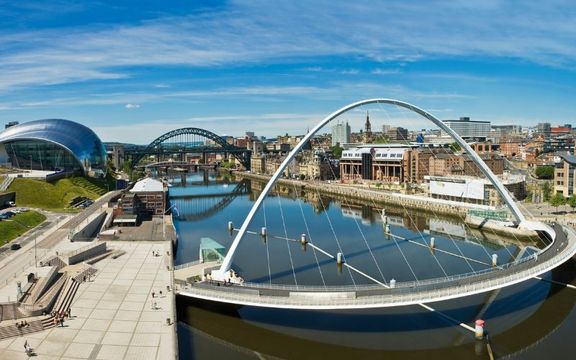
The Gateshead Millennium Bridge between Gateshead and Newcastle Getty
Known best perhaps for its contribution to football and the Industrial Revolution, Newcastle and the neighbouring town of Gateshead are often overlooked by those looking to explore British heritage, who tend to mistakenly avoid the North of England.
However, the two towns - which are separated by the River Tyne - joined forces as part of a regeneration scheme in the early 1990s and offer a unique viewpoint for those interested in history. In fact, they tell the story of an entirely different England and provide context for other historical events.
The area offers plenty of historical attractions including the Victoria Tunnel and the more modern Grey Street which was built in the 1800s and is famous for its Georgian architecture. Gateshead is also home to the breathtaking Angel of the North - an award-winning sculpture by Anthony Gormely which since its unveiling in 1998 has gone on to become one of the most viewed pieces of artwork in the world. Standing at 20m tall, the Angel has a wing span of 54m and is viewed on average by one person every second. Not bad for a piece of public art that originally divided public opinion.
Read more
Elsewhere, the area is buzzing with a thriving foodie scene and lively nightlife. Other attractions worth visiting when in Newcastle Gateshead include:
Bessie Surtees House
One for romance lovers, Bessie Surtees house - while being a fine example of Jacobean architecture, is perhaps best known as being the scene of the elopement of Bessie with John Scott, who would later become the Lord Chancellor of England. In 1772, Bessie escaped out a first-floor bedroom window to elope to Scotland with John Scott, the son of a local coal merchant. While the couple eventually returned to Newcastle and were remarried after the families reconciled, the fact that Scott later went on to become Lord Chancellor makes the story all the more scandalous!
The house itself was first recorded in 1465 and after being in the possession of Bessie’s family, went on to be bought by John Clayton in 1880. He eventually bought next door - Millbank House - set upon restoring both houses to their former glory after they had been divided up into individual dwellings and left to slide into decline. In time, both houses were sold to SR Vereker, later Lord Gort, and he and his wife employed an engineer, RF Wilkinson, to restore the houses using 17th-century architectural fittings salvaged from properties that were due to be demolished. As such, both houses now provide rare examples of Jacobean domestic architecture as they were built towards the end of the timber-framing tradition.
Bessie Surtees House was bought from the Gort estate by Newcastle City Council in 1978 and leased to English Heritage (now Historic England) in 1989. The rooms on the first floor are now open to visitors, while the rest of the building is used as offices.
Read more
Baltic Centre for Contemporary Art
Housed in an old flour mill, Gateshead's Baltic Centre for Contemporary Art on the banks of the River Tyne is one of the biggest contemporary arts venues in the world. They don't have permanent collections so there is an ever-changing calendar of contemporary art exhibitions - lasting weeks or months at a time. Currently, the Baltic will house a year-long exhibition of work by Sahej Rahal
In addition to touring exhibitions, the Baltic also holds free weekly tours of Gatehead’s Quayside area, which explores the history of The Baltic Flour Mill itself, which was a working mill from 1950 to 1982 employing up to 300 people at one time. In fact, the mill housed over 170 workers when it eventually closed down. The tour will also explore the history of the Newscastle-Gateshead regeneration as well as other quayside sites, such as the Millenium Bridge.
Newcastle Castle
Newcastle Castle stands products on the site of the fortress from which the city itself gets its name and is known to have one of the finest and most intact medieval castle keeps in all of Britain.
The castle was originally built in 122AD by the Romans as a wooden fort, but when the Normans invaded the northeast, Robert Curthose, William the Conqueror’s son, came with them and he decided to remodel the castle in an effort to showcase his family’s royal power in the north using earth and timber - giving Newcastle its name. Work on stone castle that’s known and loved today, started in 1168 and took years to complete at a cost of £1,100 which is roughly £2.5 million today.
During its long life, the castle was used as a fortress, a place for executions and as a party house for King Edward I who is believed to have visited during several Christmas seasons. Archaeological excavations between 1977 and 1992 revealed around 600 Anglo-Saxon burials in the grounds of the castle and as a result, The Black Gate’s modern Harbottle Learning Suite is named after leading archaeologist Barbara Harbottle.
Nowadays, as well as being a tourist attraction offering stunning views of the Tyne, the castle attracts locals through its rotating schedule or events - which includes cinema nights, theater performances, historical talks and even weddings!





Comments